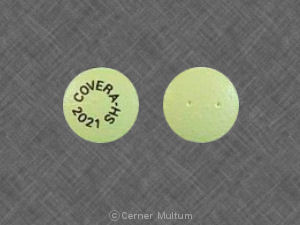Covera-HS Interactions
There are 671 drugs known to interact with Covera-HS (verapamil), along with 12 disease interactions, and 3 alcohol/food interactions. Of the total drug interactions, 131 are major, 487 are moderate, and 53 are minor.
- View all 671 medications that may interact with Covera-HS
- View Covera-HS alcohol/food interactions (3)
- View Covera-HS disease interactions (12)
Most frequently checked interactions
View interaction reports for Covera-HS (verapamil) and the medicines listed below.
- Abilify (aripiprazole)
- Accolate (zafirlukast)
- Accupril (quinapril)
- acetaminophen / oxycodone
- Aciphex (rabeprazole)
- Actonel (risedronate)
- ActoPlus Met (metformin / pioglitazone)
- ActoPlus Met XR (metformin / pioglitazone)
- Actos (pioglitazone)
- Adalat CC (nifedipine)
- Adderall (amphetamine / dextroamphetamine)
- Advicor (lovastatin / niacin)
- Advil (ibuprofen)
- Aggrenox (aspirin / dipyridamole)
- albuterol
- alendronate
- Altace (ramipril)
- Amaryl (glimepiride)
- Ambien (zolpidem)
- Avalide (hydrochlorothiazide / irbesartan)
- escitalopram
- furosemide
- Glucophage (metformin)
- Inderal LA (propranolol)
- Lanoxin (digoxin)
- Lasix (furosemide)
- quetiapine
- Synthroid (levothyroxine)
- Vitamin B12 (cyanocobalamin)
- Vitamin D3 (cholecalciferol)
Covera-HS alcohol/food interactions
There are 3 alcohol/food interactions with Covera-HS (verapamil).
Covera-HS disease interactions
There are 12 disease interactions with Covera-HS (verapamil) which include:
- aortic stenosis
- bradyarrhythmia/AV block
- cardiogenic shock/hypotension
- coronary artery disease
- liver disease
- ventricular tachycardia
- accessory AV tracts
- CHF/AMI
- hypertrophic cardiomyopathy
- neuromuscular transmission
- renal dysfunction
- GI narrowing
More about Covera-HS (verapamil)
- Covera-HS consumer information
- Compare alternatives
- Reviews (1)
- Drug images
- Side effects
- Dosage information
- During pregnancy
- Drug class: calcium channel blockers
- Breastfeeding
Related treatment guides
Drug Interaction Classification
| Highly clinically significant. Avoid combinations; the risk of the interaction outweighs the benefit. | |
| Moderately clinically significant. Usually avoid combinations; use it only under special circumstances. | |
| Minimally clinically significant. Minimize risk; assess risk and consider an alternative drug, take steps to circumvent the interaction risk and/or institute a monitoring plan. | |
| No interaction information available. |
See also:
Further information
Always consult your healthcare provider to ensure the information displayed on this page applies to your personal circumstances.


